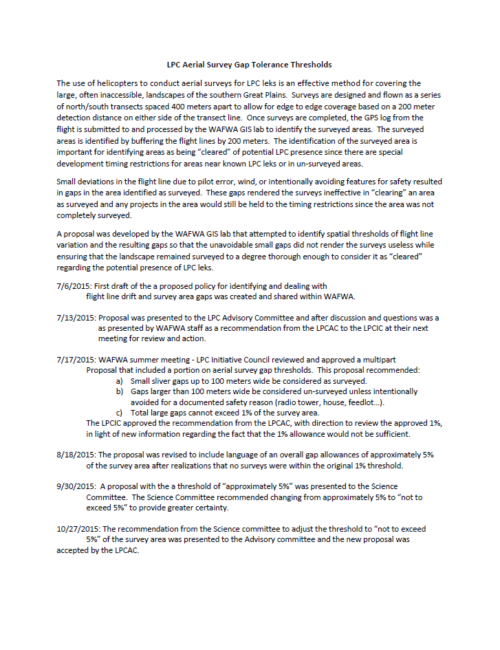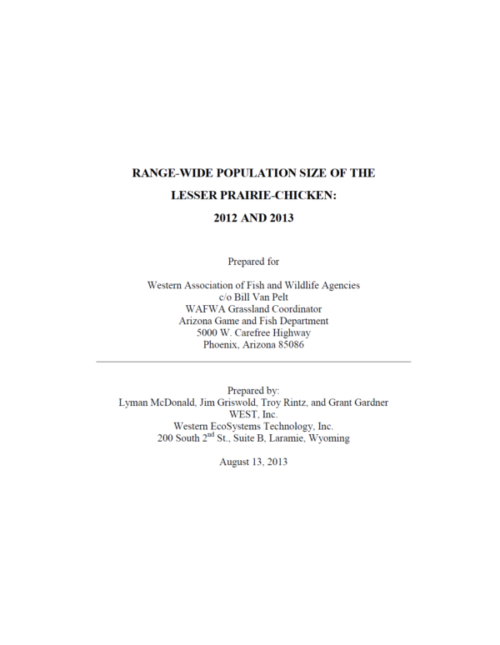Home
›
LPC Aerial Survey Gap Tolerance Thresholds
Posted by WAFWA on December 5, 2015
The use of helicopters to conduct aerial surveys for LPC leks is an effective method for covering the large, often inaccessible, landscapes of the southern Great Plains. Surveys are designed and flown as a series of north/south transects spaced 400 meters apart to allow for edge to edge coverage based…
Read More
Range-wide Population Size of the Lesser Prairie-Chicken 2012-2015
Posted by WAFWA on July 9, 2015
We estimated lesser prairie-chicken (Tympanuchus pallidicinctus; LPC) population sizes and lek abundances for four ecoregions of Kansas, Colorado, New Mexico, Oklahoma, and Texas in 2012, 2013, 2014, and 2015.
Read More
Range-wide Population Size of the Lesser Prairie-Chicken 2012-2014
Posted by WAFWA on July 31, 2014
We estimated lesser prairie-chicken (Tympanuchus pallidicinctus; LPCH) population sizes and lek abundances for four ecoregions of Kansas, Colorado, New Mexico, Oklahoma, and Texas in 2012, 2013, and 2014.
Read More
Range-Wide Oil & Gas Candidate Conservation Agreement with Assurances for the Lesser Prairie-Chicken
Posted by WAFWA on February 28, 2014
The Range-Wide Oil and Gas Candidate Conservation Agreement with Assurances for the Lesser Prairie-Chicken (CCAA) is a voluntary conservation strategy that establishes a mitigation framework which is administered by WAFWA and permitted by the U.S. Fish and Wildlife Service (FWS). Established in 2014, the CCAA is in partnership with the…
Read More
The Lesser Prairie-Chicken Range-wide Conservation Plan
Posted by WAFWA on October 1, 2013
This document is a comprehensive range-wide conservation plan (RWP) for the lesser prairiechicken (Tympanuchus pallidicinctus; hereafter LPC), and if implemented in a timely manner, is intended to preclude the need to list the LPC under the Endangered Species Act of 1973, as amended (ESA). The goal of the RWP is…
Read More
Range-wide Population Size of the Lesser Prairie-Chicken 2012-2013
Posted by WAFWA on August 13, 2013
Read More
Range-wide Population Size of the Lesser Prairie-Chicken 2012
Posted by WAFWA on September 14, 2012
Read More
Range-wide Population Estimation and Monitoring for Lesser Prairie-chickens: Sampling Design and Pilot Implementation
Posted by WAFWA on December 7, 2011
Lesser prairie-chickens (LEPC) breed in relatively open areas (e.g., low visual obstruction and low horizontal cover) of grasslands where males congregate to perform a courtship dance. This area is known as a lek. After mating, most females will nest within 3.2 km (2 miles) of the lek site. Due to…
Read More
Western Grasslands Initiative, A Plan for Conserving Grassland Habitat and Wildlife
Posted by WAFWA on July 1, 2011
It is estimated the Great Plains and desert grasslands once covered over 500 million acres stretching between Canada, Mexico and the United States. Nearly 200 wildlife species were found to use this immense sea of grass in 11 different states (parts of Arizona, Colorado, Kansas, Montana, Nebraska, New Mexico, North…
Read More
White-Tailed Prairie Dog & Gunnison’s Prairie Dog Conservation Strategy
Posted by WAFWA on May 1, 2006
The Gunnison’s prairie dog (GPD; Cynomys gunnisoni) and the white-tailed prairie dog (WTPD; C. leucurus) play an important role as potential keystone species in maintenance of the sagesteppe and prairie ecosystems. Due to a number of reasons, both species have declined in distribution and abundance throughout their ranges (Seglund et…
Read More









